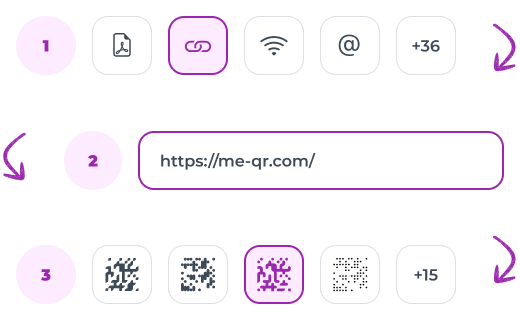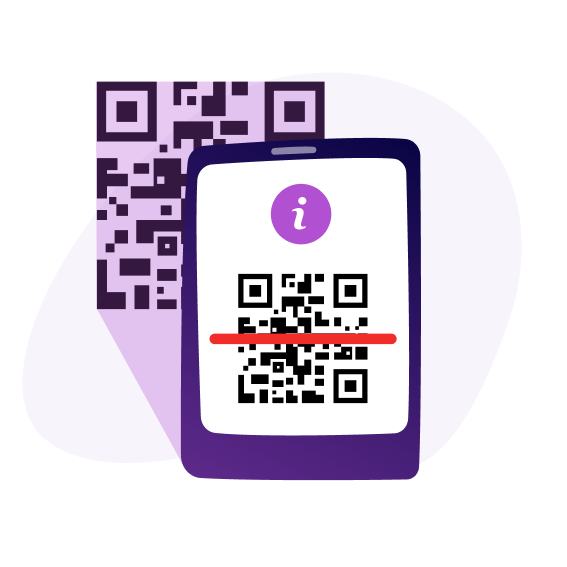Barcode and QR Code Difference
To create QR code for link, video or image - click on button below.

In a fast-paced, digital world, efficient access to information is essential. Two key tools that businesses rely on for encoding and transmitting data are QR codes and barcodes. While 2d barcode and QR code play significant roles across industries like retail, logistics, and marketing, they serve different purposes. We will compare Barcode and QR code, diving deeper and exploring their origins, applications, strengths, and challenges. Whether you're choosing one for your business or simply curious, this guide will help you understand both technologies and their roles in modern life.

Create
QR Code Now!
Put your QR code link, add name for your QR, select content category and generate!
Create
QR Code Now!
Put your QR code link, add name for your QR, select content category and generate!

A Brief History of Barcode and QR code
Barcodes were introduced in the 1970s to simplify checkout and inventory processes. They became an industry-standard in retail, with applications expanding to healthcare, logistics, and more. However, traditional barcodes have limitations in data storage capacity and scanning orientation, which prompted the development of QR codes.
In 1994, Denso Wave created QR codes (Quick Response codes) to overcome these challenges. Unlike barcodes, which store data in a linear format, QR codes use a two-dimensional matrix, allowing them to store more information and be scanned quickly from various angles. Since then, QR codes have evolved into a versatile tool for digital interactions, such as mobile payments, marketing, and contactless services.
What is QR Code and Barcode?
Both QR codes and barcodes are used to store information in machine-readable formats, but they differ in structure, usage, and capabilities. Below, we break down their unique features.
Understanding QR Codes
QR codes are 2D grids of black and white squares designed to hold information both horizontally and vertically. They are widely used in marketing campaigns, product tracking, and contactless payments. The ease of scanning with smartphones makes them popular for consumer-facing applications.
QR codes can store a variety of data to suit multiple use cases. Here are the most common types of data embedded within QR codes:
-
Text: This can include product descriptions or custom messages displayed when scanned.
-
URLs: Many QR codes link directly to websites, landing pages, or online promotions.
-
Contact details: QR code vCards or business card information can be saved with a quick scan, adding phone numbers, email addresses, or social media links to the user’s contact list.
These options demonstrate the versatility of QR codes, making them an effective tool for engaging users digitally. Whether used to direct customers to websites or store contact information, QR codes offer businesses a convenient way to deliver information seamlessly. However, despite their flexibility, they require space for proper display and rely on smartphones with cameras to be effective.


Understanding Barcodes
Barcodes are 1D sequences of parallel lines representing numerical or alphanumeric data. They are most commonly used in retail environments for product identification and pricing. Barcodes offer a simpler solution for tasks that involve scanning many items quickly and efficiently.
Below are the key types of information commonly encoded within barcodes:
-
Product numbers: These identify individual items for sales and inventory management.
-
Prices: Barcodes are often connected to point-of-sale systems to retrieve product prices instantly.
-
Inventory data: Businesses track stock availability and reorder levels through barcode-based systems.
These elements illustrate the practicality of barcodes, particularly for retail. Their simplicity and speed make them ideal for environments where rapid, repetitive scanning is needed, such as supermarkets and warehouses. However, barcodes have some drawbacks — they can store only basic information, and scanning requires precise alignment for accurate reading.
How Do Barcode and QR codes Work?
Both, barcode and QR code technologies share the same goal — delivering data with ease and speed — but they differ significantly in their structure, capabilities, and use cases. Understanding how they operate offers insights into why businesses might choose one over the other for specific tasks. While QR codes are prevalent in digital experiences and contactless interactions, barcodes continue to dominate product labeling and inventory management due to their simplicity.

The Technology Behind QR Codes
QR codes store information across a two-dimensional grid, which makes them scannable from multiple angles. Once scanned, the encoded data — whether a URL or a piece of text — becomes immediately accessible. Modern smartphones have built-in QR code readers, eliminating the need for special hardware. QR codes are widely used in contactless payments, virtual menus, and product authentication.
The Technology Behind Barcodes
Barcodes use laser-based scanners to read the width and spacing of the lines. The scanned data is then matched with records in a database, often in point-of-sale systems or inventory software. Although barcodes are reliable for repetitive scanning, they require line-of-sight and precise alignment, making them less versatile than QR codes.
What is the Difference Between QR Code and Barcode?
While both QR codes and barcodes are designed to encode and store information, they differ significantly in their structure, applications, and capabilities. Understanding these differences can help businesses and individuals select the best tool for their specific needs. Below, we explore the key distinctions between the two technologies, focusing on data capacity, scanning flexibility, and practical applications.
Structure and Data Capacity in QR Code vs Barcode
The most apparent difference lies in their design. Barcodes are one-dimensional (1D) linear codes that store data in the form of vertical lines. Each combination of lines represents simple alphanumeric information, typically limited to product codes or prices. In contrast, QR codes are two-dimensional (2D) grids that store data both vertically and horizontally, allowing them to hold more complex information.
-
Barcodes: Limited data storage, suitable for product identification and inventory tracking.
-
QR Codes: High data capacity, ideal for storing URLs, multimedia, and contact information.
This enhanced data capacity makes QR codes more versatile, allowing them to serve a broader range of purposes, from digital marketing to ticketing systems.
Scanning Flexibility and Speed of Barcode vs QR code
Another important difference lies in the scanning process. Barcodes require precise alignment to be read correctly. They are usually scanned by laser-based scanners and must be held at the right angle for accurate scanning. This makes barcodes highly effective in retail environments where products are quickly passed over a scanner at checkout.
On the other hand, QR code vs barcode speed can be scanned from any angle using smartphone cameras or dedicated scanners. They don’t require perfect alignment, making them more practical for situations where scanning needs to be fast and seamless, such as contactless payments or mobile menus.
Use Cases and Applications QR Code and Barcode
The practical applications of QR codes and barcodes also vary. Below is a breakdown of when each technology is most useful:
-
QR Codes:
-
Marketing campaigns: Providing quick access to websites, videos, or social media pages.
-
Contactless payments: Widely used in mobile wallets for quick transactions.
-
Event ticketing: Allowing users to access venues by scanning a code on their phones.
-
Barcodes:
-
Retail checkout: Quickly scanning products to retrieve prices and track sales.
-
Inventory management: Monitoring stock levels in warehouses and retail stores.
-
Healthcare: Tracking patient records, medication, and medical devices.
These applications show that QR codes are more suited for dynamic and interactive use cases, while barcodes excel in fast, repetitive tasks where simplicity and reliability are paramount.
Cost and Implementation Barcode or QR Code
When it comes to cost, barcodes are cheaper to print and easier to integrate into existing point-of-sale (POS) systems. They are widely adopted across retail industries and are often pre-printed on product packaging.
QR codes, however, require digital infrastructure, such as websites or apps, to fully leverage their potential. This makes them slightly more expensive to implement, but they provide greater value for businesses looking to engage with customers through digital channels.
What is the Difference Between QR Code and Barcode in Security Considerations
Although both technologies are generally secure, QR codes pose unique risks. A malicious QR code can redirect users to phishing websites or install malware on their devices. Businesses and consumers need to verify the source before scanning QR codes, especially in public places. Barcodes are less likely to be used maliciously but can be tampered with to manipulate product information or pricing. While both technologies offer convenience, security risks must be considered:
-
QR Codes: Can be manipulated to direct users to malicious websites or phishing pages. Always verify the source of a QR code before scanning, especially in public spaces.
-
Barcodes: Less prone to security risks but can be tampered with for fraudulent purposes in product packaging. Companies often use anti-tampering methods to prevent barcode manipulation.
To protect yourself:
-
Use security apps to scan suspicious QR codes.
-
Verify product authenticity by comparing barcode data with official product records.
Using anti-tampering methods for barcodes and security apps for QR codes can help mitigate these risks.

Future Trends of 2d Barcode vs QR code?
The future of QR codes is promising, with integration into augmented reality (AR) and interactive experiences already in development. QR codes are also being redesigned to be more visually appealing, allowing businesses to embed logos and colors within them.
Barcodes are evolving too. RFID technology is starting to replace barcodes in some industries, offering faster, contactless scanning without the need for visual alignment. However, barcodes will likely continue to dominate retail and logistics, where simplicity and cost-efficiency are crucial.
Conclusion
Both QR codes and barcodes are essential tools in today’s world, each with its strengths. Barcodes excel in speed and simplicity, making them perfect for retail and inventory tracking. Meanwhile, QR codes offer greater versatility and are well-suited for interactive, digital applications.
The choice between the two depends on your specific needs. If you need fast, reliable scanning for retail checkout or inventory management, barcodes are the better option. However, if you’re looking to engage customers or streamline digital processes, use a QR code instead of barcode.
In the coming years, both technologies will continue to evolve, playing vital roles in contactless systems and data encoding. By understanding the strengths and limitations of each, businesses and individuals can make informed decisions and maximize the benefits of these innovative tools.





















